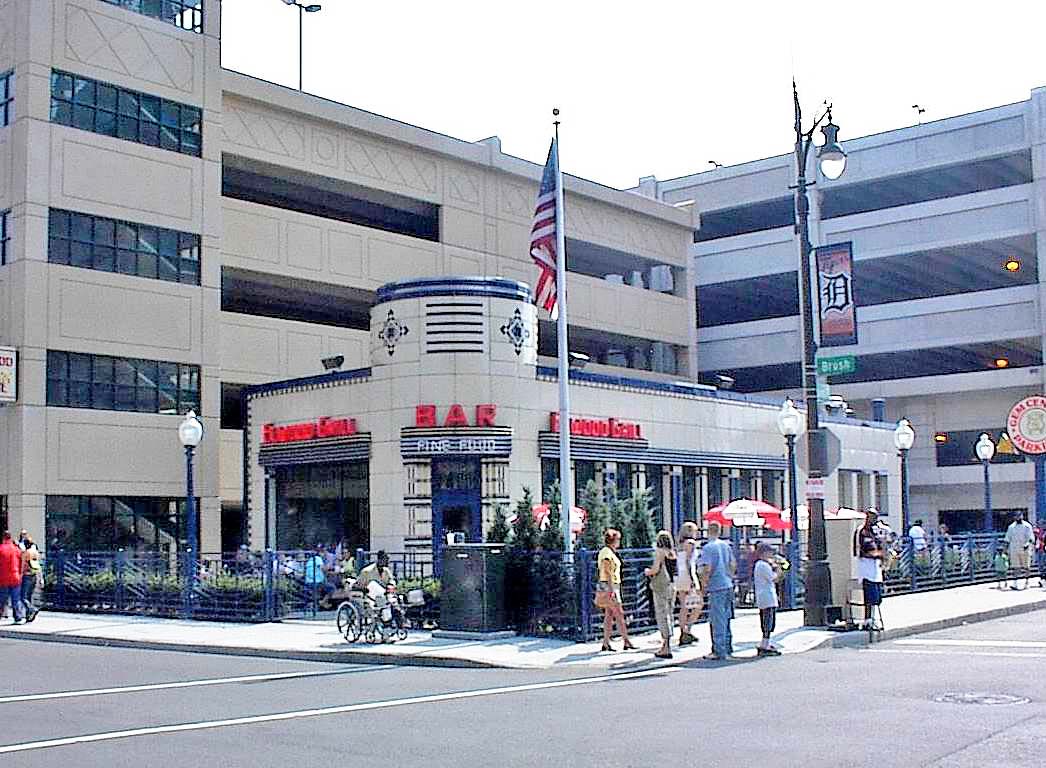
The Elwood Bar and Grill
300 Adams at Brush in downtown Detroit immediately adjoining
Comerica Park and Ford Field
This structure is small in size but extremely large in what it tells us about the huge array of architectural styles exhibited by Detroit architects and the ingenuity with which innovative buildings in the Motor City were moved or recycled to new uses. This building is, without doubt, the best example of Art Moderne in the city. The sides are sleek, streamlined steel panels in a warm cream with striking dark blue trim. Please notice how this streamlining resembles that of the streamline trains that were designed in the half-decade before World War II. Observe the attractive rounded corners of this building and contrast them to the sharp angular corners of the nearby classical building in downtown Detroit. You will also see a severely truncated mini turret on this building above the entrance. On the upper level of this turret you will see an attractive symbol with short blue horizontal stripes enclosing symbols of diamonds between those stripes. This has become the logo of the Elwood Bar and Grill. The brilliant neon signs add color with their red letters, and the long horizontal neon stripes add contrasting color and complement the streamlined exterior very effectively. Perhaps this building is best appreciated after dark when the color of the neon becomes apparent. Sometimes an architect must work effectively not only in stone, brick, steel and iron but also in neon.
This building was erected at the corner of Elizabeth and Woodward, hence the name: the Elwood. In the late 1990s, Detroit's Downtown Development Authority designed realistic plans for new baseball and football stadia. Instead of razing the Elwood, it was moved by owner Chuck Forbes to Adams and Brush preserving its distinctive architecture. The present exterior is almost exactly one that Nobles designed. And the interior was changed but the Art Deco style was carried over to the new location. This building includes a ceiling mural by Victor Ashymanets depicting the removal of this structure from Elizabeth and Woodward to its present location.
In 1925, and Exposition Internationale des Arts Decoratifs et Industriels Modernes was held in Paris. This exposition encouraged architects to use curvilinear forms with sleek exterior materials—sharp break from the architectural style of the recent past. Indeed, exterior sleekness was a mark of the Art Deco style that became briefly popular in commercial buildings, apartments and hotels. The most amazing display of the Art Deco style in the United States is located south of Lincoln Boulevard in Miami Beach but Detroit has a great example to contribute with the Elwood Bar and Grill. Art Deco was one component of a more inclusive Art Moderne style of architecture coming from France and Germany between 1920 and World War II.
Charles Nobles designed the Elmwood Bar and Grill. His other major lasting contributions to Detroit's skyline include the Lee Plaza Hotel on West Grande that also shows his talents at using the Art Deco style and the Kean Apartments on East Jefferson where the Art Deco influence is more muted.
Date of Construction: 1937
Architect: Charles Noble
Architectural Style: Art Deco at its apogee
Original location: Elizabeth at Woodward
Date of Relocation to the corner of Adams and Brush: 1997
Use in 2003: Bar and grill providing refreshments to the patrons of the Detroit
Tigers and Detroit Lions
National Registry of Historic Sites: Listed May 15, 1985
Website: www.elwoodgrill.com
Phone number: 313-962-BEER
Photo: Ren Farley July, 2003
Return to Commerical Buildings